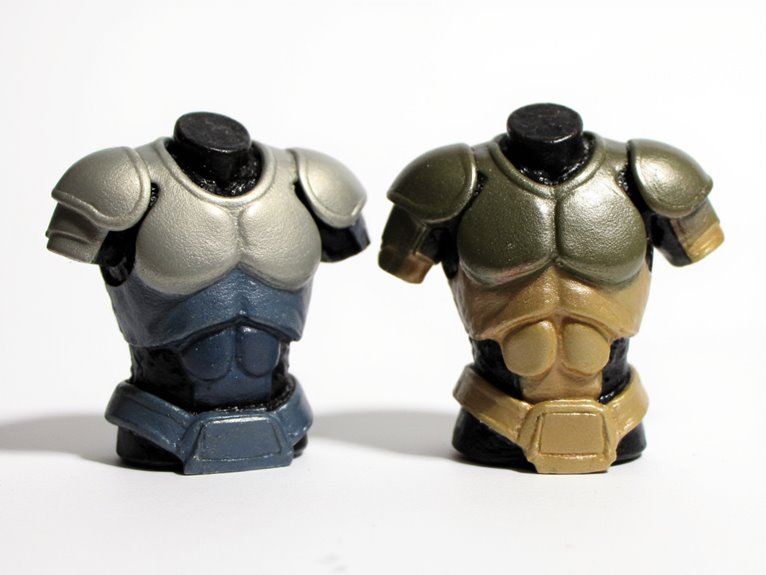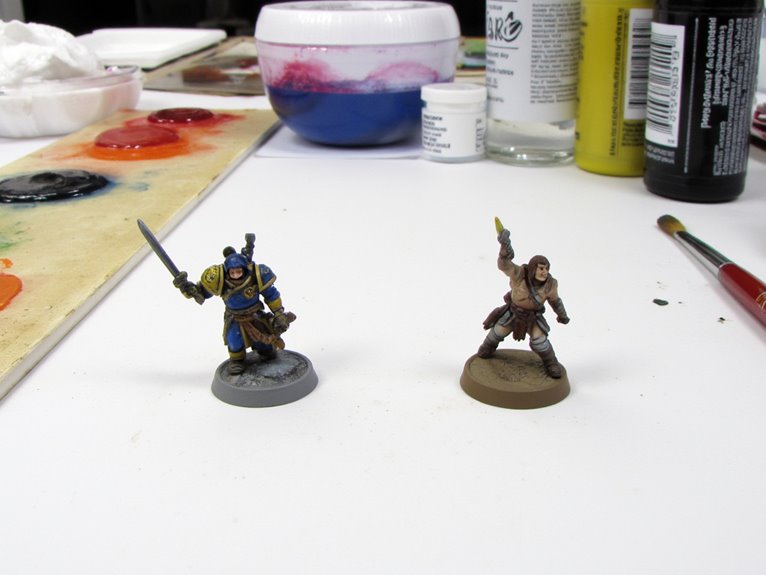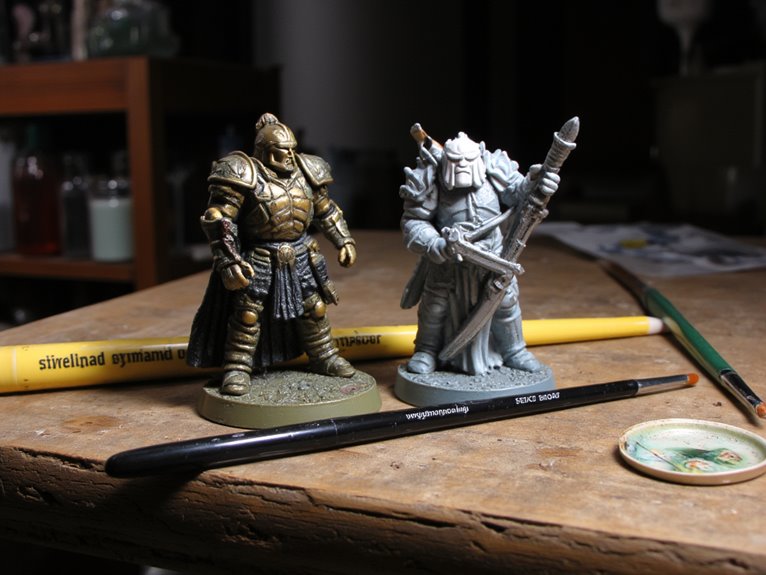We are supported by our audience. When you purchase through links on our site, we may earn an affiliate commission, at no extra cost for you. Learn more. Last update on 30th June 2025 / Images from Amazon Product Advertising API.
Acrylic paints dry to touch in 10-30 minutes, allowing rapid layer application and quick corrections, while oils take 2 days to become workable and months to fully cure. You’ll find acrylics excel at speed painting and detailed layering, but oils provide superior blending capabilities with extended working time. Acrylics clean up with soap and water, whereas oils require toxic solvents and proper ventilation. Consider your workspace safety requirements and project timelines when choosing, as advanced techniques combine both mediums for ideal results.
Notable Insights
- Acrylic paints dry in 10-30 minutes enabling rapid layering, while oils take 2 days becoming touch-dry.
- Oils excel at seamless blending due to extended working time; acrylics require quick wet-blending techniques.
- Acrylics clean easily with soap and water; oils need toxic solvents requiring ventilation and safety equipment.
- Acrylic films resist cracking and humidity; oil paints create brittle surfaces prone to yellowing over time.
- Hybrid workflows combine acrylic basecoats with oil detail work to maximize both mediums’ unique strengths.
Drying Time Differences and Their Impact on Your Painting Process
When choosing between acrylic and oil paints for miniature work, drying time becomes one of the most decisive factors affecting your painting workflow.
Acrylic paint dries to the touch within 10 to 30 minutes and fully cures in 1–2 weeks. Oil paint requires approximately 2 days to become touch dry, with complete curing taking several months.
This difference greatly impacts workflow efficiency. You’ll achieve rapid layer application with acrylics, enabling quick corrections and detailed work completion.
Oil paints provide extended working time for blending but considerably slow project timelines. Acrylic’s fast drying suits miniature painting’s detailed layering requirements, while oils risk smudging delicate features during extended curing periods. Oil paint allows for corrections and adjustments due to slow drying, making it forgiving for beginners who need time to refine their work. Both paint types can be modified with various paint mediums to adjust their drying characteristics according to your specific miniature painting needs.
Your choice depends on whether you prioritize speed or extended blending capabilities.
Blending Techniques and Layering Capabilities

Your choice between acrylic and oil paints dramatically affects how you’ll approach blending and layering on miniatures.
Acrylic’s rapid drying time forces you to work quickly during wet blending, requiring basecoat-thick consistency and multiple brushes to achieve smooth color shifts before the paint sets. Some paint brands contain flow improver that extends working time, making wet blending more manageable with acrylics.
Oil paints give you extended working time for seamless gradients and feathered blends, but they’ll slow down your layering process since each application needs more drying time between coats. The creamy texture of oils allows for particularly intricate blending effects that can enhance fine miniature details.
Wet Blending Capabilities
Although both acrylic and oil paints can achieve smooth color shifts on miniatures, their wet blending capabilities differ dramatically due to fundamental drying characteristics.
You’ll find acrylic paints dry within 15 minutes when applied thinly, severely limiting your blending window. This requires quick, controlled strokes and immediate reactivation with water to prevent hard edges. Different blending styles work better with acrylics on larger flat surfaces where you can work faster.
Pigment characteristics allow excellent coverage, but excessive water dilutes color strength. Vallejo Model Color offers the highest pigment density among water-based acrylic paints for superior wet blending performance.
Oil paints stay workable for hours or days, enabling seamless gradations without time pressure. You can create subtle tonal shifts and photorealistic effects using their buttery texture. The toothbrush technique provides an effective method for blending oil paint directly on miniature surfaces.
Mineral spirits extend working time further while maintaining pigment density, making oils superior for complex blending techniques requiring extended manipulation.
Layering Speed Differences
Beyond blending considerations, the speed at which you can build up successive layers represents one of the most significant practical differences between acrylic and oil paints for miniature work.
Acrylics become touch-dry within 15 minutes, enabling rapid successive applications without disturbing previous work. You’ll complete multi-layered compositions in single sessions.
Oil paints require days between layers, extending project timelines considerably.
This timing difference directly impacts your layering techniques. Acrylic versatility shines in quick glazing and wash applications, perfect for batch-painting multiple miniatures.
However, oils’ extended working time supports complex traditional methods like Flemish glazing. Oil richness develops through patient layer accumulation, creating luminous depth.
Acrylics excel at precise texture effects through rapid buildup, while oils allow gradual manipulation for subtle changes. Acrylics dry through water evaporation while oils undergo chemical polymerization, explaining their fundamentally different timeline requirements.
Choose acrylics for speed-focused workflows or oils for methodical, traditional approaches.
Precision Detail Work and Fine Brushwork
When you’re painting miniatures that demand razor-sharp precision, the choice between acrylics and oils fundamentally alters your brushwork approach and the quality of fine details you can achieve.
Oils provide superior brush control through their higher pigment load and creamier consistency. You’ll achieve smooth, controlled strokes that retain brush markings for texture effects. Their slow drying time allows extended manipulation of wet paint, enabling refined detail precision over hours or days.
Acrylics demand faster execution but offer immediate layering capabilities. You’ll need soft synthetic brushes since stiff bristles can plow through the lighter paint film. The rapid setting time requires quick blending before paint cures, limiting your window for fine adjustments.
Oil’s extended working time supports gradual translucent glazes that build depth in miniature features, while acrylics excel at crisp highlights without disturbing underlying layers.
Professional oil paints feature high-purity pigments that deliver exceptional covering power and fade-resistant performance essential for detailed miniature work.
Clean-Up Requirements and Safety Considerations

When you’re painting miniatures, the cleanup process differs dramatically between acrylics and oils, with significant implications for your workspace safety and environmental impact.
Acrylic paints clean up with simple soap and water, while oil paints require harsh solvents like turpentine or mineral spirits that create fumes and disposal challenges.
You’ll need to evaluate ventilation requirements, chemical exposure risks, and the environmental footprint of your chosen medium before setting up your painting station.
Water Versus Solvent Cleanup
One of the most significant practical differences between acrylic and oil paints lies in their cleanup requirements, which directly impact your workspace safety, environmental footprint, and painting session efficiency.
Acrylic paints clean with warm water alone. You can rinse brushes directly in your sink and dispose of small amounts down the drain safely. Brush care is straightforward—soap removes stubborn residues quickly.
Oil paints demand solvents like turpentine or mineral spirits for cleanup. These chemicals require careful handling due to toxicity and flammability concerns.
You’ll need dedicated brush care protocols and proper solvent storage containers with tight-fitting lids. Never pour oil paint waste down drains.
Water-mixable oils offer a hybrid solution, combining oil paint properties with water cleanup capabilities, eliminating harsh solvent requirements entirely.
Ventilation and Safety Needs
Your choice between acrylic and oil paints dramatically affects the safety requirements for your miniature painting workspace.
Oil paints demand strict ventilation requirements due to toxic solvent vapors from turpentine and mineral spirits. You’ll need mechanical exhaust ventilation that removes fumes directly outdoors without recirculation.
Acrylic paints eliminate these hazards entirely. They’re water-based and produce no harmful VOCs, drastically reducing safety protocols needed in your workspace.
Oil Paint Safety Requirements:
- Mechanical exhaust fan venting directly outdoors
- Respiratory protection with organic vapor filters
- Solvent-resistant gloves during cleanup
- Fire-safe storage for contaminated rags
Acrylics require only basic room ventilation for humidity control. This safety advantage makes them ideal for confined spaces where installing proper ventilation systems isn’t feasible.
Environmental Impact Factors
Beyond workspace safety, the environmental consequences of your paint choice extend far into clean-up procedures and long-term ecological impact.
Acrylic paints create a significant environmental footprint through microplastic contamination. When you wash brushes, plastic polymers enter wastewater systems, bypassing conventional treatment facilities and reaching aquatic ecosystems.
Oil paints present different challenges. Their linseed oil base biodegrades naturally, but cleanup requires toxic solvents like turpentine. These chemicals contaminate waterways if disposed improperly and must be treated as hazardous waste.
Pigment toxicity affects both paint types. Heavy metals in certain colors pose long-term risks regardless of your chosen medium. Acrylics rely on petroleum-derived polymers, while oils depend on natural sources but require environmentally harmful cleanup chemicals.
Color Longevity and Paint Durability Over Time
- Acrylics dry into flexible films that resist cracking under environmental stress.
- Oil paints form brittle surfaces prone to flaking when applied thickly.
- Acrylics offer superior water and humidity resistance once cured.
- Oil paints require periodic conservation treatments to prevent yellowing.
Acrylics handle temperature fluctuations better and need less maintenance due to their inherent chemical stability.
Workflow Preferences and Painting Session Management

When planning your miniature painting sessions, the choice between acrylics and oils fundamentally reshapes your workflow management and time allocation strategies.
Acrylics offer immediate readiness and water-based cleanup, enabling spontaneous painting sessions with minimal preparation overhead. Their rapid drying facilitates faster project completion but demands quick decision-making during blending.
Oils require extended preparation time with thinners and solvents, plus well-ventilated workspaces. However, this paint flexibility allows wet-on-wet blending over multiple days. You can pause and resume work on identical sections without quality degradation.
Session management with oils benefits batch painting through stepped timing flexibility. Acrylics excel for speed-focused workflows and limited-time sessions. Oils suit quality-oriented approaches where deliberate technique development outweighs session duration.
Your workspace constraints and ventilation capabilities directly influence viable paint selection for consistent session management. Regardless of your paint choice, proper surface preparation with compatible primers enhances paint adhesion and ensures professional results across multiple painting sessions.
Combining Both Paint Types for Optimal Results

Although many painters view acrylics and oils as mutually exclusive choices, combining both paint types creates a hybrid workflow that maximizes each medium’s strengths while minimizing their individual weaknesses.
Combining acrylics and oils creates a hybrid workflow that maximizes each medium’s strengths while minimizing their weaknesses.
This technique synergy follows a specific layering sequence that prevents adhesion problems. You’ll establish your miniature’s foundation with fast-drying acrylics, then add oil details for superior blending control.
The ideal combined approach includes:
- Prime and basecoat with acrylics for rapid color blocking
- Apply oil paints over completely dry acrylic layers
- Thin oils with mineral spirits for smooth color interaction
- Use oils selectively for highlights and shadow shifts
You can’t reverse this process—never apply acrylics over oils.
The color interaction between mediums produces depth impossible with single-medium techniques, while acrylic’s quick drying prevents workflow bottlenecks.
On a final note
You’ll find success with either paint type once you understand their distinct properties. Acrylics offer faster drying times and easier cleanup, making them ideal for beginners and detailed work. Oils provide superior blending capabilities and extended working time for advanced techniques. Your choice depends on your skill level, available workspace, and project requirements. Many experienced painters combine both mediums strategically, using acrylics for base coats and oils for final details and weathering effects.


